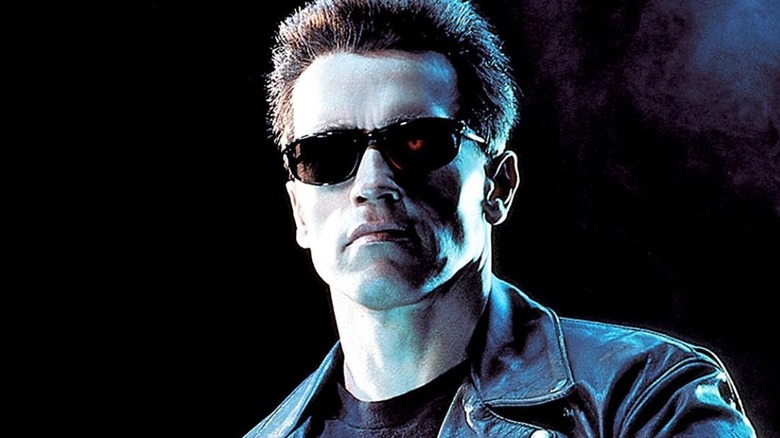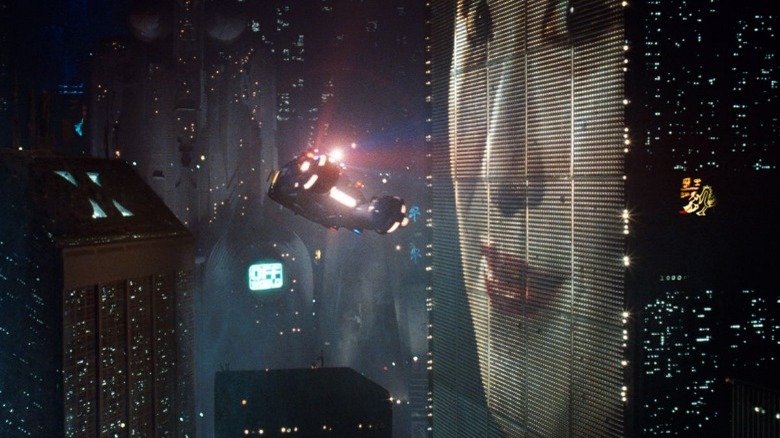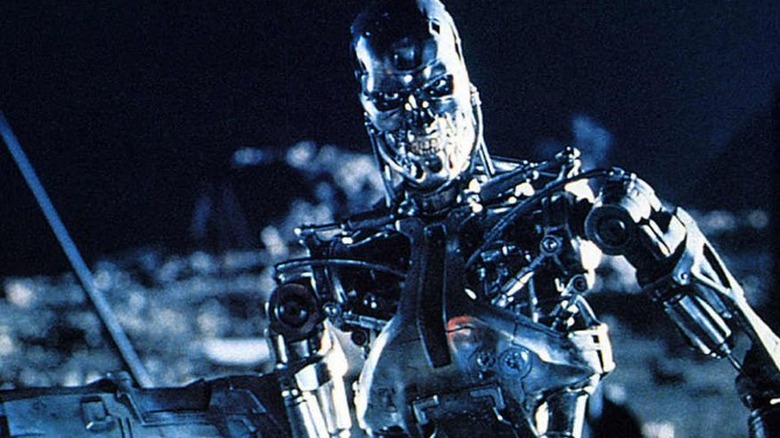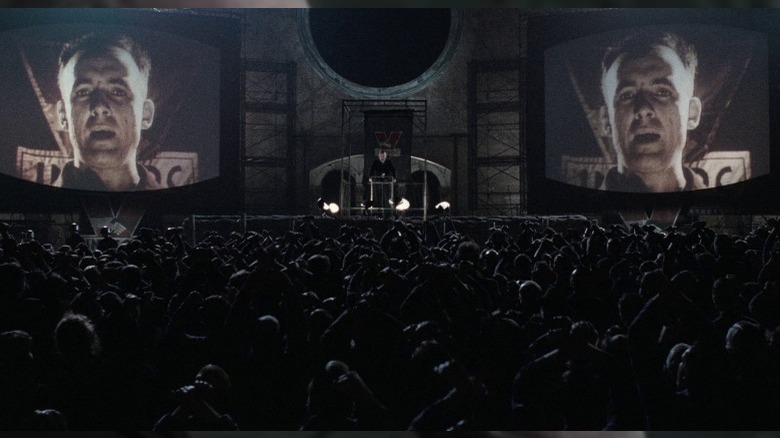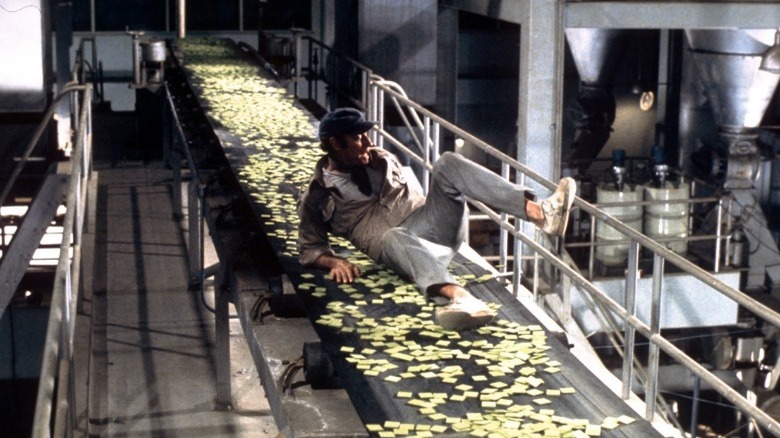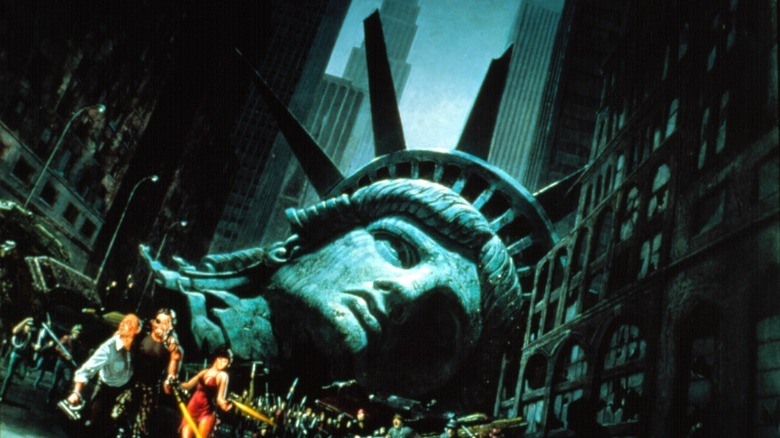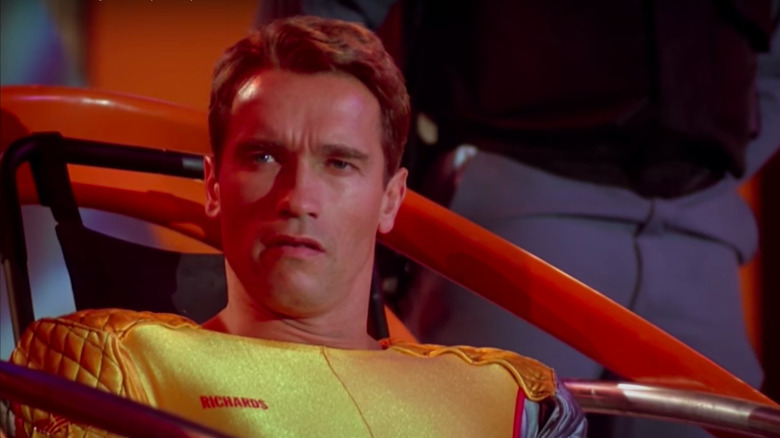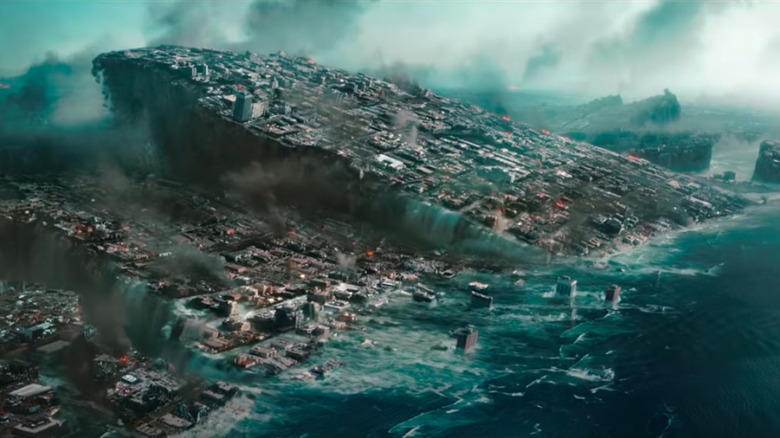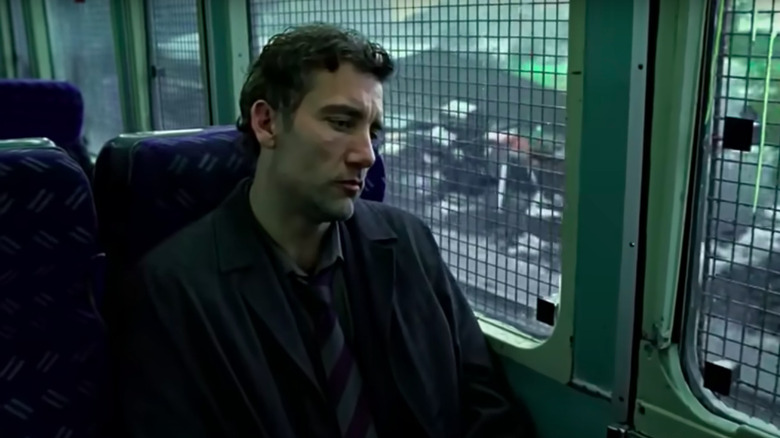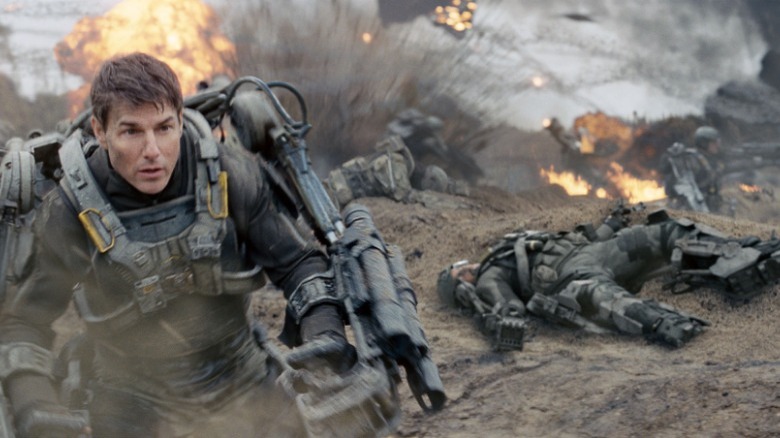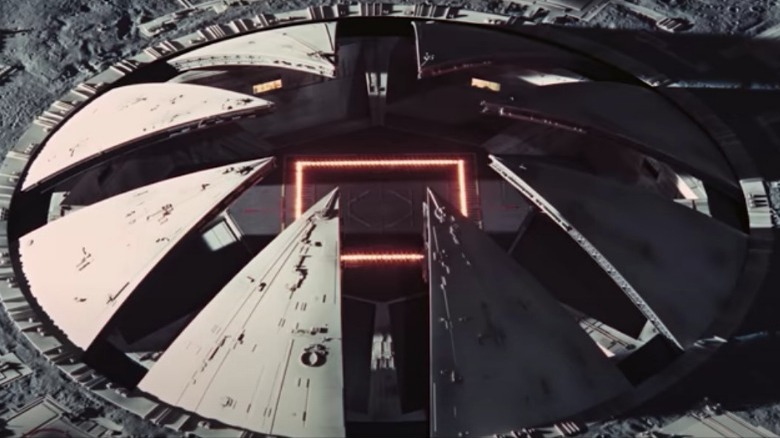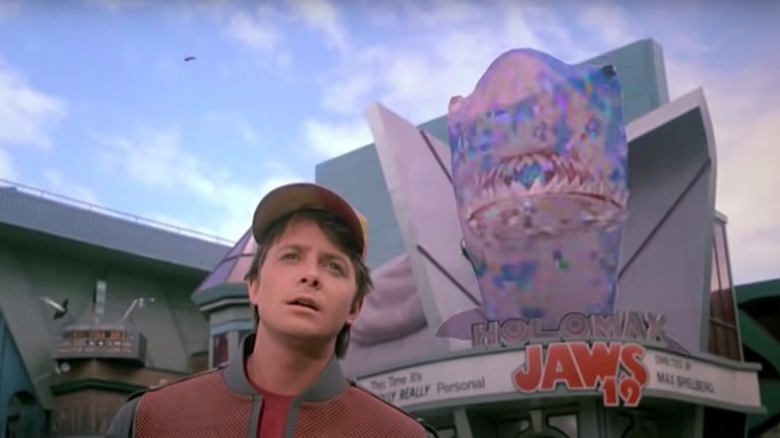Things Predicted In Futuristic Sci-Fi Movies That Never Came True
In film, futurism often falls within the domain of science fiction, a genre that's been part of cinema since the medium's inception. For example, 1902's "A Trip to the Moon" depicted a surreal vision of a spacecraft crashing into the moon, creating perhaps the most iconic image of cinema's silent age. Later, in his 1927 film "Metropolis," director Fritz Lang brought a vast cityscape made up of Art Deco skyscrapers intersected by flight paths and towering monorail tracks to life.
"Metropolis" is set in 2026, not far from our present day, so it is safe to say that the Art Deco canyons of Lang's imagination will not materialize. "Metropolis" isn't the only science fiction film to envision a world that proved to be fictional, either. From "Terminator 2" and "Children of Men" to "2001: A Space Odyssey," here are a few films that made predictions about the future that didn't come true.
Replicants, flying cars, and blocky video calls — Blade Runner
Set in the year 2019, Ridley Scott's "Blade Runner" depicts a dark, ominous Los Angeles filled with enormous digital billboards, flaming industrial chimneys, and colossal pyramids surrounded by flying cars whirring through the inky night sky. Now, downtown LA has changed over the last 40 years, with the construction of the U.S. Bank Tower being the most notable example, but in the real 2019 there were neither pyramids nor flying cars.
That's not to say that Los Angeles hasn't seen futuristic spectacles, though. In October 2018, SpaceX launched the Falcon 9 rocket, which created an awesome glare over the California coast (via Quartz). Still, the Los Angeles of "Blade Runner" is very different, especially the replicant humanoids, which display far greater intelligence, agility and human likeness than today's robot technology, which, as this CNET report shows, is rudimentary by comparison.
However, "Blade Runner" underestimated 2019, too. For example, as the BBC notes, a scene in which Deckard (Harrison Ford) has a video call with Rachel (Sean Young) is dated even by the standards of 20 years ago. In 2019, instead of using some blocky relic, one could have had a video call on a five-inch smartphone.
Judgment Day — Terminator 2
"Terminator 2" opens with a vision of Los Angeles on August 29, 1997, better known as "Judgment Day." While the direct aftermath of the apocalyptic event isn't shown — the film quickly jumps ahead two decades — we can easily surmise what happened from the images that follow. By 2029, the city has been reduced to a gray, ashen wasteland strewn with rubble, skeletons, and mangled steel. Narrating, Sarah Connor (Linda Hamilton) explains that three billion people died on Judgment Day, the victims of a "nuclear fire" directed by the malicious artificial intelligence known as Skynet.
Thankfully, there was no nuclear fire on the real August 29, 1997. The worst thing that happened on that date? Well, Reed Hastings and Marc Randolph spent that late summer Friday co-founding Kibble, which would soon change its name to Netflix (via Wired). So, it was an inauspicious day for Blockbuster and other video rental stores, but a far cry from the apocalyptic events of "Terminator 2."
There's always a caveat, though. You'd hope that James Cameron's sequel was another far-fetched Hollywood film — and, by the standards of the day, it was. However, technology advances at a remarkable pace, and the latest news is disconcerting. In June 2022, Google employee Blake Lemoine was suspended for violating the company's non-disclosure policies when he suggested that Google's artificial intelligence had become sentient, arguing that the AI displayed "feelings, emotions, and subjective experience" (via The Verge).
Extreme superstate totalitarianism — 1984
Directed by Michael Radford, "1984" is the film adaptation of George Orwell's enduring novel of the same name. Like the book, Radford's film depicts an extreme authoritarian superstate named Oceania, which covers Britain, Ireland, the Americas, Australia, New Zealand, and a large swathe of southern Africa.
As the title suggests, the story unfolds in the year 1984, and follows Winston Smith, a lowly worker at the Ministry of Truth in "Airstrip One," the land formerly known as England. Oceania is ruled by Ingsoc, a totalitarian regime that operates with the slogan "War is peace. Freedom is slavery. Ignorance is strength." Ingsoc controls the population with a raft of extreme measures, including the Thought Police, a lawkeeping organization that uses microphones, telescreens, informers, and other surveillance tools to root out "thoughtcrime."
Fortunately, in the real 1984, England was still called England, and it existed not in Oceania but in the United Kingdom, its own sovereign state. There were no Thought Police, either, nor any concept of "thoughtcrime." However, "1984" continues to become more prescient as time goes on. Recently, The Washington Post has noted the Trump administration's use of Orwellian "newspeak," and points out that the National Security Agency made widespread use of electronic snooping during the Obama era.
Starvation, climate change, and overpopulation — Soylent Green
Starvation, climate change, and overpopulation are all issues in the early 21st century, but not to the extent depicted in "Soylent Green," a 1973 film that envisioned the New York of 2022 as a barren, dystopian hellscape. The opening montage outlines the general state of humanity and charts its move from the countryside to the cities, which became crammed, filthy, and dysfunctional to the point where widespread starvation and chasmic inequality are commonplace.
"Sounds accurate," some may quip, but let's give the Big Apple a fair shake. New York City may have its problems, but it is in far better shape than director Richard Fleischer imagines. First of all, "Soylent Green" puts New York's population at some 40 million; in reality, only 18.8 million people live in the New York metropolitan area. In the film, this massive overpopulation puts a disastrous strain on food supply, which is also affected by advanced climate change that, thankfully, is not yet known to the real New York (via Den of Geek).
Consequently, most ordinary New Yorkers, such as NYPD detective Thorn (Charlton Heston), must survive on fake, synthetic foods. There are parallels here, of course. The plant-based food industry is on the rise, and is expected to be worth $10.80 billion by 2028, according to Fortune Business Insights. The parallels are facile, though, as in the real New York City jam doesn't cost $150, and alternative diets are a matter of choice, not dystopian necessity (they also don't involve products made out of human beings — not yet, anyway).
Manhattan, prison island — Escape From New York
John Carpenter's "Escape From New York" is set in 1997, when Manhattan has become a super prison full of dangerous criminals. Few people would dare enter this cyberpunk fortress, but after Air Force One crashes into the island, Snake Plissken (Kurt Russell) is tasked with gliding into the city and searching the site for survivors. The dystopia is not limited to Manhattan and New York, either; in this timeline, the United States is still at war with the USSR, causing untold hardship.
Fortunately, 1997 came and went without any of that nastiness. In fact, the real New York of 1997 was a city on the mend. Mayor Giuliani's "zero tolerance" policy saw crime rates fall by 44%, with murder plumetting by 70%. There are wider geopolitical differences, too. John Carpenter imagined a conflict between the United States and the USSR, but the latter had ceased to exist by the real 1997, having collapsed some six years prior.
Murderous TV shows — The Running Man
The likes of "Jerry Springer," "Dr. Phil" and "The Jeremy Kyle Show" can be pretty exploitative, but reality TV hasn't degenerated into showcasing outright murder just yet. That's not what "The Running Man" expected of 2017, though. Adapted from a Stephen King novel, Paul Michael Glaser's film depicts an American police state in which alleged criminals are mutilated and killed on television in order to distract the people from the government's tyranny and ongoing societal dysfunction.
The show's host, Damon Killian (Richard Dawson), takes much glee in narrating the convicts' suffering. However, Killian gets more than he bargains for when he sends Ben Richards (Arnold Schwarzenegger) through "The Running Game." Framed for a massacre in Bakersfield, California, Richards proves to be a worthy adversary to Fireball, Dynamo, Captain Freedom, and the other "stalkers" who are tasked with killing him in the show's elaborate arenas.
Mayan cataclysm — 2012
Roland Emmerich's "2012" is a fun disaster movie about the Mayan 2012 prophecy, which gained traction in the run up to December 21, 2012, the final date on the 5,125-year-long Mayan long-count calendar (via National Geographic). Some surmised that this date signified the end of the world, a view popularized by books such as Lawrence Joseph's "Apocalypse 2012: A Scientific Investigation into Civilization's End." Others, such as University of Florida anthropologist Susan Gillespie, said this doomsaying was caused by "[the] media and ... other people making use of the Maya past to fulfill agendas that are really their own."
None of this stopped Sony-Columbia spending some $200 million on "2012," which sees director Roland Emmerich destroy just about every famous monument, natural and man-made, on God's green earth (via The Wrap). Obviously, critics and audiences recognized the film as a bit of a lark. Roger Ebert wrote, "This is fun. '2012' delivers what it promises, and since no sentient being will buy a ticket expecting anything else, it will be, for its audiences, one of the most satisfactory films of the year."
Global infertility — Children of Men
"Children of Men" is set in 2027, but it depicts the results of two decades' worth of human infertility, which has wrecked most of the world and reduced the United Kingdom to a quasi-war zone. Our protagonist is Theo (Clive Owen), a cynical bureaucrat who is enlisted to help a resistance movement fighting against the tyrannical police state governing Britain.
Director Alfonso Cuaron was praised for his arresting one-shot sequences, especially a six-minute scene that sees Theo travel through dystopian Bexhill-on-Sea, a former seaside town turned refugee camp that erupts into violence. In The Independent, critic Anthony Quinn wrote, "Alfonso Cuaron stages some terrific set-pieces, and the production designers deserve credit for making London in 2027 look like the grunge capital of the world, i.e., like now, only more so. One small problem: I didn't believe any of it."
To Quinn's credit, there's good reason to reject the premise of the film. After all, in 2006, the year of the film's release, the Office for National Statistics projected that the British population would rise from 60 million in 2006 to 65 million in 2016 and 70 million in 2028. According to Woldometer, the 2022 U.K. population stands at 68.2 million, while the United States government claims that the global population is 7.9 billion. Clearly, those numbers are going up, not down.
Alien invasion — Edge of Tomorrow
Based on the light novel "All You Need Is Kill" by Japanese author Hiroshi Sikurazaka, "Edge of Tomorrow" concerns a hostile alien invasion of Earth in the year 2015. Directed by Doug Liman, the film follows Major William Cage (Tom Cruise) as he navigates a time loop and immense battles against hyper-agile aliens that look like deep sea creatures crossed with Marvel's Venom.
Thankfully, we got through 2015 without being invaded by aliens, and no army deployed troops wearing elaborate battle suits, either. A defining feature of "Edge of Tomorrow" is the arsenal used by the troops stationed at the European command headquarters in London. Instead of carrying rifles, pistols, and other firearms, they're strapped into a metal frame armed with a cannon and machine guns. It's a powerful bit of kit, but it lacks maneuverability.
While the film may not have offered an accurate vision of the future, it was well-received by critics. The Rotten Tomatoes consensus reads, "Gripping, well-acted, funny, and clever, 'Edge of Tomorrow' offers entertaining proof that Tom Cruise is still more than capable of shouldering the weight of a blockbuster action thriller."
Trips to Jupiter — 2001: A Space Odyssey
The early 2020s has seen the birth of a new space race, with much of the buzz coming not from NASA but the private sector. On July 11, 2021, CNBC reported that Richard Branson, CEO of Virgin Galactic, had achieved his childhood dream of reaching space. He was followed 10 days later by Jeff Bezos, who was launched into space aboard one of his own Blue Origin rockets (via CNN).
These were heady experiences, no doubt, but they were child's play compared to the space tourism of "2001: A Space Odyssey," which features manned space flights to Jupiter, the solar system's largest planet. In reality, nine spacecraft have been sent to Jupiter, all of them unmanned and much smaller than the Discovery One spacecraft seen in the film.
However, two of the real-world vessels, Galileo and Juno, have managed to orbit Jupiter, arriving at the planet in 1995 and 2016, respectively. Considering that it took several years for those spacecraft to reach Jupiter, technology will have to improve greatly before we see a real-life Discovery One.
Jaws 19 — Back to the Future Part II
In "Back to the Future Part II," Marty McFly finds himself in 2015, where he sees a cinema adorned with a holographic marquee for "Jaws 19." The display proceeds to lurch forward and "bite" him, terrifying McFly before he quips, "The shark still looks fake." Years later, in the real 2015, Universal poked fun at its shark franchise with a mock trailer for "Jaws 19."
As beloved as the original "Jaws" is, the series deserved to be mocked. "Back to the Future Part II" was released in 1989, two years after the "Jaws" franchise insulted audiences with "Jaws: The Revenge," the fourth film in the series. In criticizing this surreally awful film, it is difficult to choose the first angle of attack, so lets quote the Rotten Tomatoes consensus: "Illogical, tension-free, and filled with cut-rate special effects, 'Jaws: The Revenge' is a sorry chapter in a once-proud franchise."
However, despite the negative reviews, "Jaws: The Revenge" still turned a profit, earning $51,881,013 against a budget of $23,000,000 (via Box Office Mojo and The Numbers). Thankfully, we didn't get 15 more sequels.Hollywood is a business, and "Jaws" is a legendary intellectual property; you'd think that some sort of sequel or reboot would have been attempted over the past decade or so, but it seems that "The Revenge" was just too mortifying. Besides, the void that was left in its wake has been filled by the likes of "Sharknado" and the shameless rip-off known as "Cruel Jaws."
